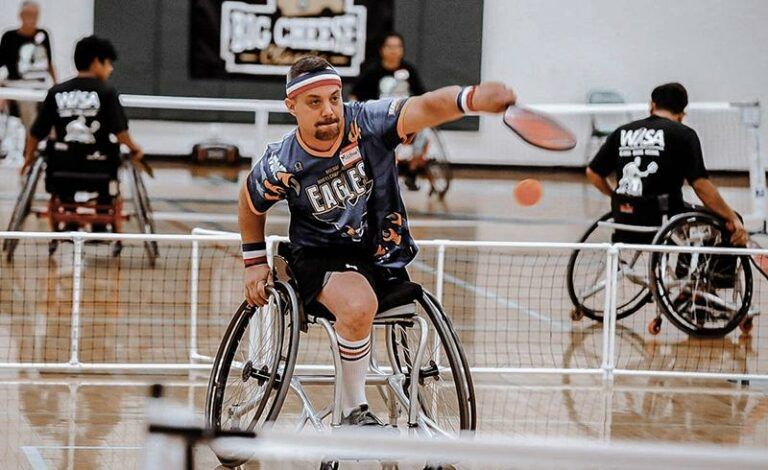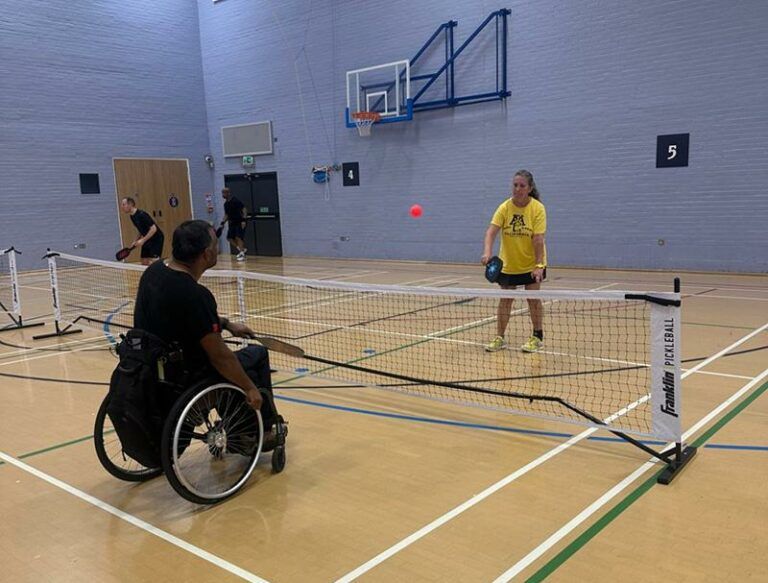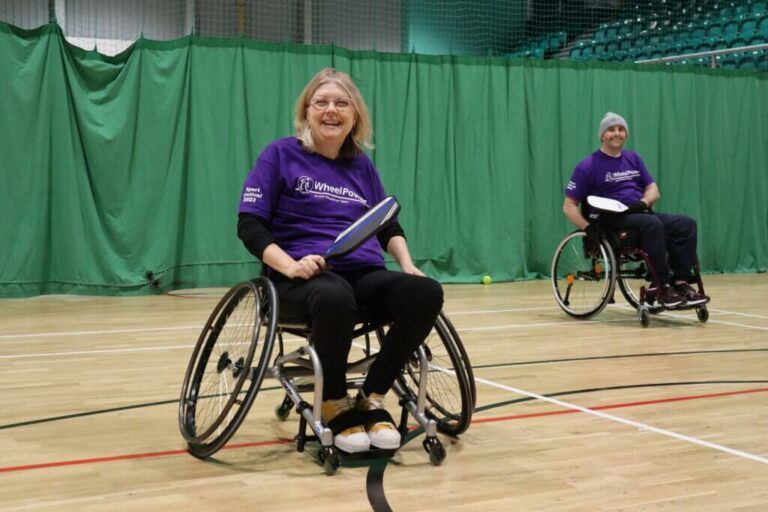What is wheelchair pickleball?
At its core, adaptive pickleball preserves the essence of traditional pickleball while making necessary adjustments for wheelchair sports. Played on a larger court with modified rules, wheelchair pickleball accommodates the unique requirements of wheelchair athletes. The joy of hitting the ball, strategizing against opponents, and the thrill of scoring transcends physical limitations, creating an environment where competition is not limited by the body but defined by spirit and determination.
Wheelchair pickleball allows inclusive sports to be at the forefront, uniting people of diverse backgrounds while fostering sportsmanship and camaraderie. The sport encourages players to break barriers and form connections that may not be possible in everyday life. Its ability to cultivate friendships and shared experiences speaks volumes about the impact of adaptive sports in promoting a sense of belonging.

Who can play?
The beauty of wheelchair pickleball lies in its inclusivity. Disability inclusion is a fundamental principle that underpins this adaptive sport, making it accessible to various individuals. Whether you're a seasoned athlete or new to the game, wheelchair pickleball welcomes all particularly adaptive athletes and para athletes who seek an avenue for physical activity and competition.
Even able-bodied participants can join in the fun, often participating in mixed doubles and learning from the remarkable abilities of their wheelchair-bound counterparts. This inclusion creates a more comprehensive understanding of empathy and respect for each other’s challenges and triumphs. Additionally, players often find themselves motivated by each other’s perseverance, adding depth to the emotional experience of the game.
A sport on the rise: history and growth
The realm of wheelchair pickleball is experiencing rapid growth, illuminating the potential of Paralympics through recreational avenues as athletes redefine the limits of their capabilities. Starting as an offshoot of traditional pickleball, wheelchair pickleball has garnered recognition in recent years, attracting diverse players across age groups and backgrounds.

Growth trends in adaptive sports demonstrate increasing interest and participation; local clubs, schools, and recreational leagues are incorporating wheelchair pickleball into their programs. The wheelchair pickleball community has built a strong network that promotes skill development, as individuals from various locales advocate for visibility and inclusivity in sports.
Wheelchair Pickleball Rules: shared rules with standing pickleball
As wheelchair pickleball continues to develop, it’s essential to understand the foundational rules and shared aspects with the traditional version of the game. While embracing a spirit of innovation and adaptability, many principles from standing pickleball remain intact, ensuring that athletes carry forward the spirit of competition.
Court dimensions and layout
One significant difference lies in the pickleball court size. In wheelchair pickleball, the dimensions stretch to 74 feet by 44 feet, granting players more freedom to maneuver. This adjustment caters to the unique turn radius and mobility of wheelchairs, creating a space where players can showcase their abilities without feeling confined.
The layout still adheres to general pickleball guidelines, allowing players to feel comfortable and confident on the court. A standard dimension along with a maintained playing surface is crucial for optimal play. Elevated performance thrives in environments designed for success, encouraging athletes to focus on tactics and execution rather than battling physical constraints.
Serving sequence and scoring
Pickleball scoring and serve rotation are crucial elements of the game, and they remain consistent with traditional rules. Players earn points when the opposing side fails to return the ball properly. However, some adaptations have been made, such as enhanced focus on maintaining accessibility in serving areas for wheelchair athletes, which ensures fairness and promotes smooth gameplay.
Gameplay fundamentals: volleys, dinks, groundstrokes
The fundamental gameplay of wheelchair pickleball bears resemblance to its standing counterpart. Players may utilize a blend of strategies, including volleys, dinks, and groundstrokes to outmaneuver opponents. Mastery over these pickleball shots allows athletes to gain control over the match, creating opportunities to penetrate defenses and score points.

However, wheelchair players face unique challenges bound to their equipment. Understanding the adaptations for successful shot execution is essential. By refining techniques, players enhance their confidence in shot selection with proper positioning and timing, ensuring they can effectively contribute to the team’s effort while relishing the experience of the game.
Faults and common mistakes
Common pickleball rule violations can lead to points lost or changes in ownership of the serve. Awareness of fundamental faults such as stepping into the non-volley zone improperly or failing to adhere to service rules aids in reducing frustration and promoting smoother gameplay. By staying vigilant and informed, players can navigate the court more effectively and maintain momentum in matches.
The two-bounce rule: a wheelchair player's strategic advantage
Unique to wheelchair pickleball is the double bounce rule, allowing players to let the ball bounce twice before returning it. This adaptive rule empowers wheelchair athletes by granting them additional time to maneuver and set up their shots, showcasing an essential layer of strategy inherent in the game.
Explanation and implications of the two-bounce rule
The very essence of the double bounce rule caters to the needs of players with mobility challenges. It provides a second chance similar to giving one more breath before diving into the depths of the ocean. This rule grants wheelchair players the opportunity to assess the situation before making their move, translating into more effective shot selection and propelling them forward strategically.
Controlling the pace of the game
Controlling the pace of the game becomes a tactical weapon; players can dictate tempo while also slowing down rallies that could otherwise favor swift opponents. By utilizing the double bounce advantage, athletes position themselves to tire out adversaries, orchestrating an emotional rollercoaster that shifts the power dynamics in the match.
Creating unpredictable shots and angles
With the capacity to leverage the double bounce rule, players can engineer unpredictable shots, leaving adversaries grappling with the unexpected. This tactic cultivates an atmosphere of creativity and surprise while allowing players to maintain the upper hand. Through these skilled maneuvers, wheelchair players engage in a dynamic dance, striking a balance between athleticism and strategy.
Serving in a wheelchair: technique and positioning
Serving in wheelchair pickleball stands as a critical facet, where proper technique and positioning dictate the effectiveness of the game. Understanding the adjustments for wheelchair players fosters a sense of confidence and mastery over one of the most pivotal aspects of gameplay.
Rear wheel placement behind the baseline
A legal serving position demands that the rear wheels of the wheelchair remain within the designated serving area. This positioning is essential for ensuring that serves comply with standardized rules, minimizing the chance of service faults. Visualizing the court and adhering to proper placement can significantly enhance accuracy and overall performance.
Effective serving motions for wheelchair players
Developing adapted serving techniques allows wheelchair players to maximize their reach and generate the necessary power to propel the ball effectively. Just like a painter requires the right tools to fulfill their vision, athletes must refine their serving motions to achieve precision and success.
Common serving errors and how to avoid them
Being aware of wheelchair-specific serving faults may prevent verbose errors, fostering a consistent and confident game. Prioritizing stability and practicing movements aids in steering clear of common pitfalls, ensuring gameplay is fluid and natural within the unique framework of adaptive pickleball.
The non-volley zone (kitchen): wheelchair-specific considerations
Navigating the non-volley zone, commonly referred to as the kitchen, presents its unique set of challenges and considerations for wheelchair users. With established guidelines specific to that aspect, players will soon learn the intricacies while adapting to the dynamic nature of the game.
Front wheel allowance within the NVZ
In wheelchair pickleball, players are permitted to maneuver with their front wheels inside the non-volley zone. This advantageous rule allows for more offensive opportunities while navigating the court effectively. However, understanding and adhering to the volley restrictions is crucial to maintaining compliance with the rules.
Rear wheel restrictions and re-establishing position
While the front wheels enjoy freedom within the non-volley zone, the back wheels must remain outside while executing shots. This regulation encourages players to be mindful of their positioning, emphasizing the importance of avoiding NVZ faults while maintaining effective court coverage.
Examples of legal and illegal volleys in a wheelchair
Understanding the distinctions between legal and illegal volleys can significantly impact a player’s performance. Visual representations and tactical discussions can illuminate the path to mastering this crucial aspect of wheelchair pickleball, ensuring all participants are well-versed in rule clarity.
Wheelchair maneuvering: tips for efficient court coverage
Achieving efficient court coverage is paramount for wheelchair players, as the ability to react swiftly and strategically can dictate the outcome of matches. Mastery over movements, court positioning, and anticipation transforms gameplay from ordinary to extraordinary.
Mastering turns, pivots, and acceleration
Controlling the wheelchair through precise turns, pivots, and accelerated movements ensures optimal play and proactive responses. Developing a strong grasp of wheelchair control enhances an athlete’s capacity to respond to shots dynamically, enabling them to navigate challenges with grace and agility.
Court positioning and reacting to opponents
Positioning oneself effectively in response to adversaries reinforces defensive strategies while enhancing offensive capabilities. Understanding optimal locations to intercept or defend allows wheelchair players to engage in a dance across the court, actively participating while anticipating opponents’ intentions.
Importance of anticipation and reading the play
A player’s tactical awareness plays a significant role in success. Building on predicting shots and reading the opponent’s play propels athletes beyond physical limitations, engaging their minds and instincts in a harmonious display of skill and effort.
Inclusive play: wheelchair and standing players together
The establishment of inclusive practices fosters a sense of belonging while enhancing the overall experience of wheelchair pickleball. By emphasizing etiquette and communication, players learn to embrace diversity in gameplay and cultivate collaborative relationships.
Etiquette and communication for mixed matches
In mixed matches involving both wheelchair and standing players, respectful gameplay and clear communication emerge as groundbreaking principles. Encouraging dialogue fosters teamwork and cooperation, breaking down barriers while enhancing the shared experience of the sport.
Understanding the distinct rules for each player type
Clarifying rule variations between wheelchair and standing players ensures fair play during competitions. Preparing for different scenarios allows everyone participating to anticipate and strategize effectively, creating an environment where sportsmanship thrives.
Celebrating the inclusive spirit of pickleball
As a community, embracing the adaptability of pickleball and perpetuating a welcoming environment creates a socially favorable atmosphere. Celebrating the achievements and camaraderie among all players reinforces the underlying mission of adaptive sports to foster relationships and admiration for the beauty of competition.
Wheelchair and adaptive equipment: gearing up for success
Equipping wheelchair athletes with the proper tools is vital for optimizing their performance on the court. From specialized wheelchairs to adaptive paddle grips, the emphasis on gear enhances players’ confidence and success in gameplay.
Types of wheelchairs ideal for pickleball
The design of sports wheelchairs tailored for pickleball plays a crucial role in elevating the playing experience. Customization options that cater to individual needs, such as lightweight materials and precise wheel placement, contribute to optimal maneuverability and control during matches.
Strapping and safety considerations for stability
Understanding the importance of securing positioning with proper strapping and safety considerations remains paramount for injury prevention and stability. Athletes must ensure they are comfortably strapped into their wheelchairs, allowing them to focus solely on the game without concern for instability.
Adaptive paddle grips and modifications
Finding the right paddle can have a significant impact on a player’s comfort and control. Customizing grip styles and materials enhances performance and fosters a unique connection to the sport, allowing athletes to express themselves and their individual playing styles effectively.
Finding wheelchair pickleball communities and resources
Locating opportunities within the wheelchair pickleball community is fundamental for fostering engagement and participation. From clubs to tournaments, these resources create a rich tapestry of support and camaraderie for aspiring players.
Locating clubs, groups, and tournaments
Discovering local clubs and groups serves as an excellent starting point for newcomers. Engaging with the pickleball partners within the community opens doors to competitive opportunities and enriching experiences, enhancing an athlete’s journey through the sport.
Adaptive sports programs and facilities
Specialized instruction provided through adaptive sports programs ensures all athletes receive the support they need for success. These facilities promote accessibility and create an environment that nurtures individual growth, allowing players to thrive within their unique circumstances.
Connecting with other wheelchair pickleball players
The value of connection within the wheelchair pickleball community cannot be overstated. Finding online communities and participating in social media groups fosters an environment where shared experiences can be exchanged, bolstering morale, and inspiring dedication to the sport.
The future of wheelchair pickleball: growth and paralympic potential
As the momentum of wheelchair pickleball accelerates, the future appears brighter than ever, teeming with promise and possibilities. By raising awareness and promoting inclusivity, we can serve as advocates for a sport that fosters resilience and determination.
Expanding the sport and increasing participation
Creating and implementing awareness initiatives serves to raise the profile of wheelchair pickleball. Highlighting tournament growth and comprehensive media coverage ensures individuals appreciate the sport's competitive nature, driving increased interest in participation.
Advocacy for greater accessibility and inclusion
Removing barriers to entry for wheelchair athletes plays a pivotal role in creating an equitable playing field. Supporting efforts to procure adaptive equipment access and facilitate opportunities reinforces the foundations of a welcoming environment for everyone to thrive.
Inspirational stories of wheelchair pickleball athletes
Sharing the achievements and journeys of wheelchair pickleball athletes captivates hearts and minds. These motivational figures inspire future generations, creating a legacy of resilience that embodies the very spirit of competition while highlighting the immense potential within the growing community.
Conclusion
Wheelchair pickleball has emerged as a symbol of adaptability and inclusivity, perpetuating the belief that sports transcend physical limitations. By acknowledging and embracing the specific rules and adaptations designed for wheelchair athletes, we enhance the overall experience of the sport while fostering a sense of community among players. As we continue to advocate for growth, accessibility, and recognition, the magnificent world of wheelchair pickleball shall evolve, welcoming new players, celebrating resilience, and fostering the spirit of competition.










